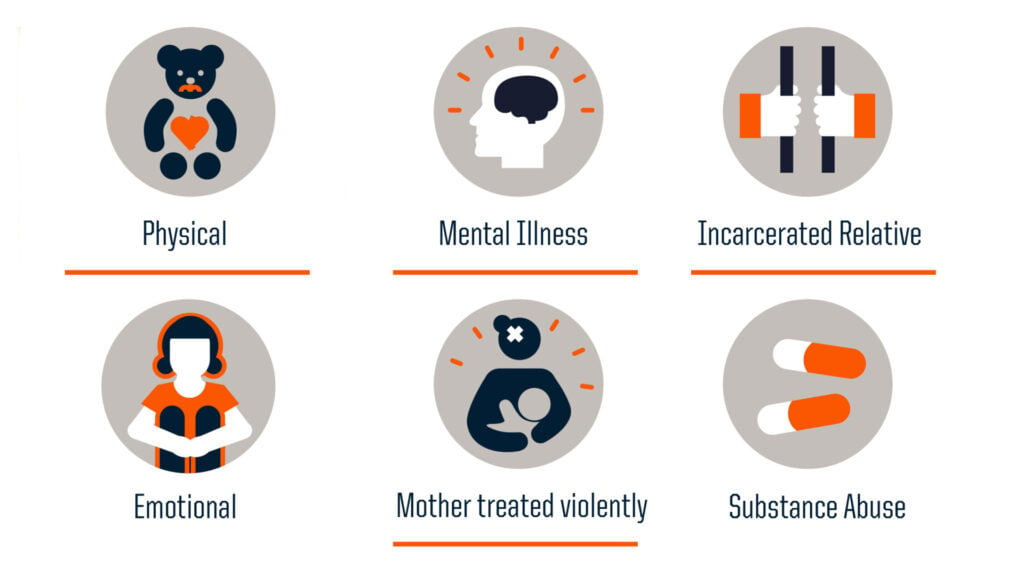Hambrick, E. P., Brawner, T. W., Perry, B. D., Brandt, K., Hofmeister, C., & Collins, J. O. (2019). Beyond the ACE score: Examining relationships between timing of developmental adversity, relational health and developmental outcomes in children. Archives of Psychiatric Nursing, 33(3), 238-247.

Relationships between timing of adversity, relational health and developmental outcomes in children
The 1998 Adverse Childhood Experiences (ACEs) study demonstrated a strong correlation between adversity/trauma in childhood and negative health and social outcomes later in life.
This helped raise awareness of the impacts of early adversity among the public, policymakers, and service providers. Screening for ACEs has become more common.
ACE score quantifies exposure to different types of adverse childhood experiences to assess their cumulative impact. It has become an important public health tool for understanding links between childhood adversity and lifelong health. The score represents a simple but powerful connection between childhood trauma and adult wellbeing.
However, the simplicity of the ACE framework can lead to misunderstandings about causality. There is a need to move beyond just screening for ACEs to address the impacts of childhood adversity effectively.
Factors like the timing/developmental stage of adversity, surrounding caregiving contexts, and heterogeneous outcomes associated with early trauma need to be considered.
Simply being aware that adversity matters is only the first step. The informed development of interventions, programs, practices, and policies requires a more nuanced, research-based understanding of how early adversity impacts development.
Key Points
- The timing of adverse and relationally impoverished experiences in early childhood is associated with children’s later functioning across multiple developmental domains.
- Experiences of adversity or relational poverty during the perinatal period (birth to 2 months) are most strongly associated with compromised functioning later in childhood.
- Lack of relational health during the perinatal period had a stronger negative association with later outcomes than adversity during this period.
- After the perinatal stage, the influence of relational poverty diminished while adversity remained impactful, particularly in infancy and early childhood.
- Children’s degree of current relational health was the strongest predictor of their overall functioning.
Rationale
Examples of Adverse Childhood Experiences (ACEs) include abuse (sexual, physical and emotional); neglect (physical, emotional); and household dysfunction (parental separation, domestic violence, household substance abuse; household mental illness; household imprisonment).
The 1998 ACEs study demonstrated powerful associations between childhood adversity and negative health and social outcomes later in life (Felitti et al., 1998).
This prompted efforts in medicine, public health, education, and human services to become “trauma-informed” by screening for ACEs and related risk factors. However, the ACE framework has limitations in informing intervention efforts.
Namely, it does not account for the developmental timing of adversity, the influence of relational contexts surrounding adversity, or the heterogeneous outcomes associated with early adversity (Cicchetti & Toth, 1995; Toth & Cicchetti, 2013).
Organizational theories of development suggest early childhood may be an especially sensitive period. Adversity occurring when the brain is rapidly developing can profoundly impact the foundations for developmental capacities emerging later in life (Perry, 2001; Dunn et al., 2017).
For example, extreme deprivation in orphanages impacts cognitive and social-emotional outcomes (McDermott et al., 2013). The precise developmental timing of adversity and the surrounding caregiving context likely influence outcomes.
This study aimed to closely examine associations between the specific developmental timing of adverse experiences (AE) and relational poverty (RP), as well as current relational health (RH), with children’s neurodevelopmental functioning across 32 domains.
This analysis can inform intervention efforts targeting the impacts of childhood adversity.
Method
This study utilized a pre-existing dataset of 3523 children ages 6-13 years receiving mental health services.
The dataset included adverse experiences (AE), relational health (RH), and neurodevelopmental functioning metrics completed by clinicians as part of the Neurosequential Model of Therapeutics (NMT).
Clinicians completed NMT metrics based on clinical evaluations and record reviews. AE and RH experiences were coded for timing and severity across four developmental periods: perinatal (birth-2 months), infancy (2-12 months), early childhood (13 months-4 years), and childhood (4-11 years). Neurodevelopmental functioning across 32 domains was rated on a 1-12 scale.
NMT Metrics
The NMT Metrics systematically measure adversity, relational health, and functioning over developmental time to guide trauma-informed treatment.
- The NMT Metrics are a set of clinical tools used as part of the Neurosequential Model of Therapeutics (NMT).
- Clinicians complete the NMT metrics based on clinical evaluations and record reviews.
- There are four main components:
- Part A measures developmental adversity (AE) – timing, severity and type of traumatic/adverse experiences.
- Part B measures developmental relational health (RH) – quality of caregiving relationships over time.
- Part C measures current neurodevelopmental functioning across 32 brain-mediated domains.
- Part D measures current relational health.
- Parts A and B rate adverse events and relational poverty across four developmental periods: perinatal, infancy, early childhood, childhood.
- Part C uses a 12 point scale to rate developmental domains from severe dysfunction to normal adult functioning.
- The metrics produce an assessment of developmental history, current functioning, and relations that inform clinical intervention planning.
Sample
The sample included 3523 children ages 6-13 years (mean age 8.5 years) receiving mental health services, 66% male and 34% female.
Racial/ethnic composition was 42% White, 16% Black, 8% Hispanic, 2% Asian, 2% Native American, and 16% Other.
Participants were receiving services across 190 clinical sites in the U.S., Canada, Europe, and Australia. Most sites served primarily outpatient clientele.
Statistical Analysis
Associations between developmental timing of adversity and relational poverty and current neurodevelopmental functioning were tested using regularized hierarchical regression modeling.
Regularization helped control for correlations between adversity and relational poverty over time.
Results
- Perinatal adversity (birth-2 months) was strongest associated with neurodevelopmental impairment, followed by infancy adversity.
- Lack of relational health (poverty in nurturing, attuned relationships with caregivers) during the perinatal period was more negatively associated with outcomes than perinatal adversity.
- While perinatal adversity was most impactful, adversity in infancy (2-12 months) and early childhood (13 months-4 years) continued to show significant negative associations with impairment.
- Children’s degree of current relational health was the strongest predictor of their neurodevelopmental functioning.
Insight
In the analysis, disruptions to relational health with caregivers during the first 2 months of life showed an even stronger negative association with children’s developmental functioning later in childhood than traumatic adversity faced during the same period.
In other words, a profound lack of stable, caring relationships in the first two months was a more damaging predictor of long-term outcomes than traumatic experiences occurring in those early months.
This highlights how essential positive early caregiving experiences are for life-long development, over and above facing directly traumatic events. The perinatal period may represent a sensitive developmental window where nurturing care plays an especially crucial role in shaping children’s future growth.
After the perinatal stage (birth-2 months), relational poverty became less influential compared to adverse experiences like abuse, neglect, and household dysfunction as predictors of later impairment.
This likely reflects the decreasing dependence on caregivers for basic regulation and survival as infants become more robust. Yet relational health remained vital; children’s current relationships strongly predicted their developmental functioning despite early adversity.
This research confirms clinical wisdom and developmental theory regarding early childhood as an especially sensitive period.
It further demonstrates the primacy of caregiving relationships in mitigating the impacts of adversity.
Infants build relational templates to judge trustworthiness and safety. Receiving inconsistent safety messages during this sensitive period can profoundly alter attachment and stress systems with enduring effects.
Intervening to prevent disrupted care in the earliest months of life and improving relational health throughout childhood may profoundly shape developmental trajectories.
Strengths
- Large sample size (N = 3523) allowed for sophisticated statistical analyses to parse apart multiple dimensions of early experience
- Precise measurement of developmental timing of adversity and relational poverty across four stages of early childhood
- Inclusion of diverse clinical settings and geographic regions enhances generalizability
- Use of regularization techniques in analysis helped control for intercorrelations between adversity over time
Limitations
- Retrospective clinician report of early adverse experiences may be less reliable than prospective measurement
- Lack of additional psychological or academic outcome measures beyond clinician-rated neurodevelopmental function
- Limited demographic details restrict examination of cultural differences
- Unable to determine specific effects of intervention children received
Clinical Implications
These findings demonstrate the profound influence of early caregiving disruptions, especially in the first two months of life, on developmental trajectories.
This highlights opportunities for preventative intervention through supporting families during pregnancy, childbirth, and infancy.
All perinatal providers can educate families about the importance of consistent, attuned care and screen for emerging disruptions in relationships or safety. Home visiting programs may help support vulnerable families.
Boosting relational health broadly across development can also mitigate early insults. Clinically, prioritizing early intervention for young children with disrupted attachment is warranted given lasting neurodevelopmental consequences.
Communities should coordinate efforts to embrace families with infants and reduce isolation and stress, while promoting secure caregiver-child relationships. Useful programs include home visiting, lactation support, faith groups, WIC.
Programs, practice, and policy must align with the significance of early caregiving relationships revealed in research.
References
Primary reference
Hambrick, E. P., Brawner, T. W., Perry, B. D., Brandt, K., Hofmeister, C., & Collins, J. O. (2019). Beyond the ACE score: Examining relationships between timing of developmental adversity, relational health and developmental outcomes in children. Archives of Psychiatric Nursing, 33(3), 238-247.
Other references
Cicchetti, D., & Toth, S. L. (1995). A developmental psychopathology perspective on child abuse and neglect. Journal of the American Academy of Child & Adolescent Psychiatry, 34(5), 541-565. https://doi.org/10.1097/00004583-199505000-00008
Dunn, E. C., Nishimi, K., Powers, A., & Bradley, B. (2017). Is developmental timing of trauma exposure associated with depressive and post-traumatic stress disorder symptoms in adulthood? Journal of Psychiatric Research, 84, 119-127. https://doi.org/10.1016/j.jpsychires.2016.09.004
Felitti, V. J., Anda, R. F., Nordenberg, D., Williamson, D. F., Spitz, A. M., Edwards, V., Koss, M. P., & Marks, J. S. (1998). Relationship of childhood abuse and household dysfunction to many of the leading causes of death in adults: The Adverse Childhood Experiences (ACE) Study. American Journal of Preventive Medicine, 14(4), 245–258. https://doi.org/10.1016/s0749-3797(98)00017-8
McDermott, J. M., Troller-Renfree, S., Vanderwert, R., Nelson, C. A., Zeanah, C. H., & Fox, N. A. (2013). Psychosocial deprivation, executive functions, and the emergence of socio-emotional behavior problems. Frontiers in Human Neuroscience, 7, 167. https://doi.org/10.3389/fnhum.2013.00167
Perry, B. D. (2001). The neuroarcheology of childhood maltreatment: The neurodevelopmental costs of adverse childhood events. In K. Franey, R. Geffner, & R. Falconer (Eds.), The cost of child maltreatment: Who pays? We all do (p. 15–37). Family Violence and Sexual Assault Institute.
Toth, S. L., & Cicchetti, D. (2013). A developmental psychopathology perspective on child maltreatment. Child Maltreatment, 18(3), 135-139. https://doi.org/10.1177/1077559513500380
Keep Learning
- What aspects of early caregiving experiences might be most essential for healthy development, and how might we characterize and measure these?
- How could we study the specific neurobiological mechanisms impacted by early caregiving disruptions underlying the developmental impairments observed?
- What interventions show the most promise for remediating neurodevelopmental insults stemming from deficient care in infancy and early childhood?
- What social, political and economic factors perpetuate conditions of adversity, instability and relational impoverishment for families with young children, and how might these be addressed?
- How might educational institutions help equip all students with an understanding of early childhood as a sensitive period to inform their contributions to society?

